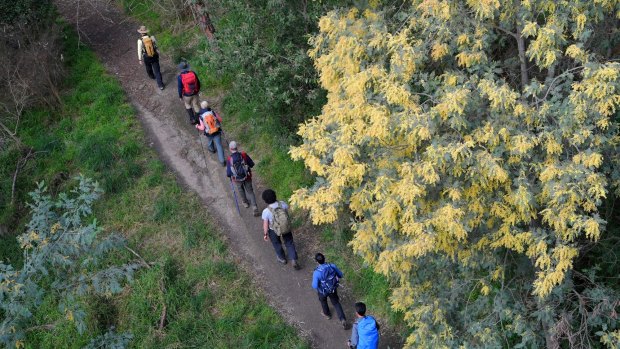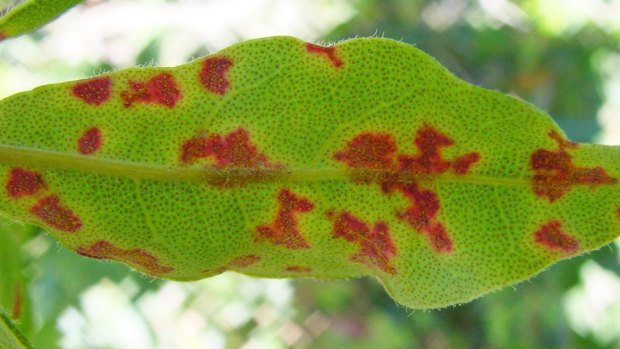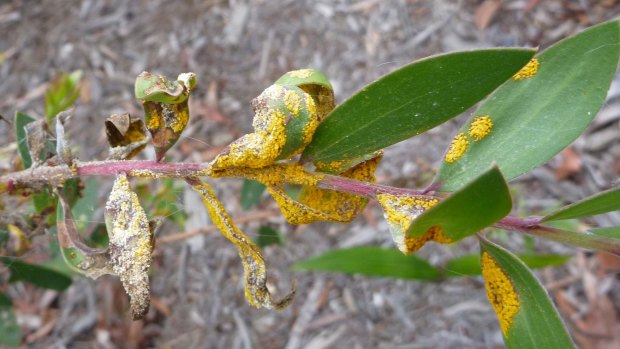This was published 7 years ago
Dozens of native plant species at 'immediate risk' from fungus import: botanist
By Peter Hannam
Bushwalkers and other travellers heading to Victoria and Tasmania over the summer are advised to take care to avoid spreading a fungus that has already placed dozens of native plant species at "immediate risk".
So far, the two states have only identified the imported myrtle rust in nurseries but its rapid spread along Australia's east coast in just a few years underscores the challenges facing biosecurity staff in all states to contain the fungus.

Bushwalkers and other travellers may inadvertently spread a fungus that is deadly for dozens of native plant species.Credit: Joe Armao
The devastating rust has been blamed for killing about 57 per cent of adult native guava trees, a common shrub along the east coast in just a few years.
Some 380 species among the Myrtaceae family of plants, ranging from eucalypts to paperbarks, are considered susceptible to the rust.

Myrtle rust infects the leaves of susceptible plants, particularly in moist regions.Credit: Damon Cronshaw
"It's very unusual among rust fungi in that it's got an extremely wide host range," said Bob Makinson, a conservation botanist and vice president of the Australian Network for Plant Conservation, adding most rusts only threaten a couple of species.
"There are about 50 species of immediate concern" in Australia, said Dr Makinson, ahead of a two-day workshop on myrtle rust control attended by government agencies and scientists that began on Tuesday in Canberra.
Along with wild species at risk, the emerging lemon myrtle and aniseed myrtle plantation industries are threatened, as are many plant nurseries, prompting the involvement of state agriculture bodies.
Rapid spread
The fungus does best in moist forests and woodlands and has spread widely since its first detection at Wyong, near Gosford in NSW, in 2010. (See map below.)
It is not yet clear how it will fare in the biodiversity-rich south-west of Western Australia. With a few exceptions, such as the Clarence River catchment of northern NSW, the rust has mostly been confined so far to about 40 kilometres of the coast.
The rust attacks new growth, such as leaves, preventing flowering. Seedlings are also particularly vulnerable, creating the potential for a rapid spiral decline of susceptible species.
The fungus is spread by microscopic airborne spores that can also accumulate on hats, tents and other gear used by travellers, such as bushwalkers. Its entry into Australia is unknown.
"It could have been somebody going for a bushwalk in Hawaii and then going for a bushwalk here," Dr Makinson said of its introduction to Australia.

Myrtle rust spores attacking a paperbark species.
Increasing travel and trade are raising the risk from bio-threats for both wildlife and agricultural sectors.
"What we're seeing is a very marked acceleration of the movement of some of these diseases out of their native areas and into new ones," he said.
Along with the myrtle rust already found in Australia, there are two other "rather more aggressive" that are affecting eucalyptus plantations in South America but are yet to be detected outside the continent, he said.
Control measures
The rust penetrates and infects leaves of susceptible plants. Treatment of diseased plants includes coating them with sticky sprays before their removal to avoid the inadvertent spread of spores into the air.
Standard washing-machine use with detergent will kill the spores on clothing.
Similarly, bush travellers can concoct a mix of 75 per cent methylated spirits and 25 per cent water to spray on tents and other equipment to kill the spores, Dr Makinson said.
He said New Zealand had taken a more proactive response to the arrival of myrtle rust, making more on-ground surveys to identify its spread.
It has started "a massive seed bank", particularly of plants found to be particularly resistant to the fungus, for future restoration of vulnerable plants, an approach Australia should follow.
"We're seven years down now and we haven't got a coordinated response so far," said Dr Makinson, who was formerly a senior researcher at the Royal Botanic Garden in Sydney for 15 years.
Preservation efforts
A spokesman for NSW's Environment Minister Gabrielle Upton said the state's government "is commencing a project under its $100 million Saving our Species program to help manage the threat".
"The Royal Botanic Garden Sydney and Australian Botanic Garden Mount Annan are part of a network of Australian botanic gardens raising awareness, providing expertise and establishing conservation programs in response to the threat of myrtle rust," he said.
A spokesman for the NSW Department of Primary Industries said two species, Rhodamnia rubescens and Rhodomyrtus psidioides, have recently been provisionally listed as critically endangered, "in part as a result of the impact of Myrtle rust".
"People carrying out activities where there is potential to spread myrtle rust to vulnerable species or plant communities are advised to take precautions to minimise risk," he said, adding the DPI website had more details about its management.
Other work in NSW includes the Royal Botanic Garden, which has also led workshops in New Zealand, Papua New Guinea and Indonesia to prepare and respond to myrtle rust.
The NSW PlantBank, which has been storing seeds of all the state's species, is targeting plants threatened by the fungus, an OEH spokeswoman said.
Since many myrtle species have seeds that do not survive traditional seed banking methods, research is developing new techniques such as plant tissue and cryo-preservation.